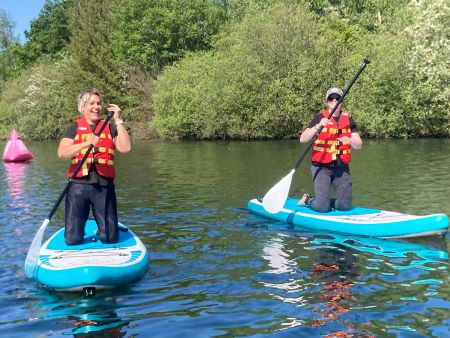I am asked two questions more than anything else when I talk about my SUP Yoga classes:
- Can I do SUP Yoga if I’ve never been on a paddleboard?
- Can I do SUP Yoga if I don’t currently do Yoga?
When I first meet my class on Sunday afternoon, I ask two very similar questions:
- Have you ever been on a paddleboard?
- Do you do yoga?

Each week, I receive a full range of responses. I have class members for whom paddleboarding is a regular hobby, and others who have never been on a SUP. Similarly, I have experienced yoga teachers as well as participants who have never practiced yoga. Each week, by the end of the class, novices in either discipline will have enjoyed the experience.
New to Paddleboarding
Many SUP Yoga classes spend most of the time doing yoga rather than paddling, so your paddling skill becomes less relevant. I’ve participated in SUP Yoga classes where the location for the yoga is within meters of the launch point, so almost as soon as you are kneeling on the board, the yogi will connect you to their anchors.

My yoga docking station is at the other end of the lake from the launch point, which is about 300 meters. I give a quick dry land lesson on how to kneel on the board and how to paddle. Once I’ve launched people on their boards, I paddle next to them and provide basic instruction on how to paddle. There is no need to stand up; instead, two strokes of the paddle on the left and then two strokes on the right side in a kneeling position will soon get my class where they need to be. I find that paddling down the lake is great therapy; we even call it a mindful paddle. By the time we reach the docking station, it has been a good relaxation.
Once we are doing yoga, my commentary helps my class with their balance. By the end of the lesson, they have a good idea of the board’s stability. If it is not windy, we usually stand up to mountain pose, and many novices use this same technique to stand up when they are paddleboarding.

New to Yoga
SUP Yoga, by its nature, is likely to be less demanding than a normal yoga class, as basic poses take more concentration than on land. Whether you are an experienced yogi or a novice, the floating yoga board equalises our practice.
My classes flow but slowly, so people can easily transition between poses, even if the poses are new to them. I also give careful commentary explaining where each hand or foot needs to be placed for the asana; it can almost become like yoga twister in some ways. Again, if you are new to yoga, this helps.

In a SUP Yoga class, the teacher is likely to be closer to their students than in a dry land class. For example, I stand in the middle of the docking station, which means I am only a couple of meters from my students. They can see me clearly, and I am close enough to give bespoke instruction if their limbs are in the wrong place, affecting their balance.
Why Not Give It a Go?
So, if you’ve never been on a paddleboard, rarely done yoga, or both, there is no reason why you cannot give it a try. You may find it inspires you to take up paddleboarding or join a dry land yoga class too.
You will certainly have a lot of smiles as you try!
Paul teaches a weekly SUP Yoga classes at Activities Way in Lincoln
Main – Photo by Pew Nguyen




